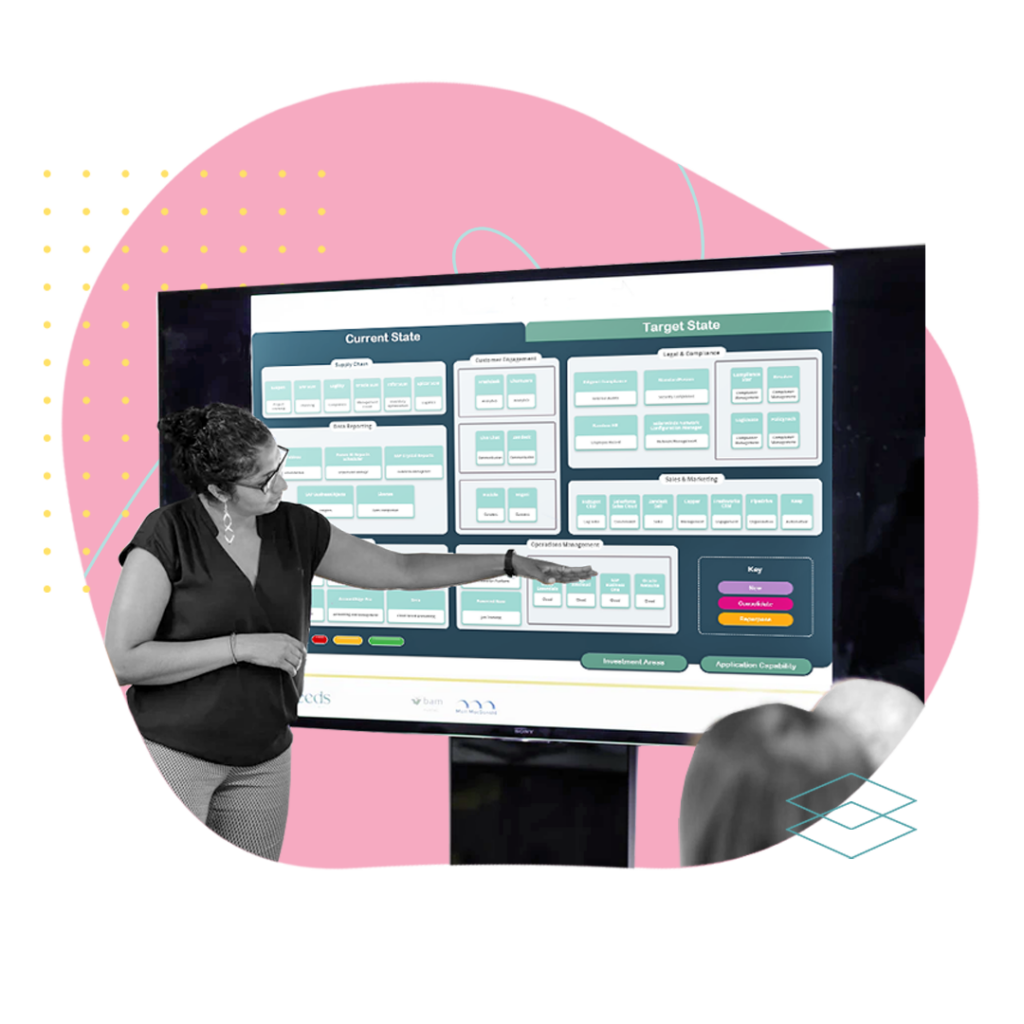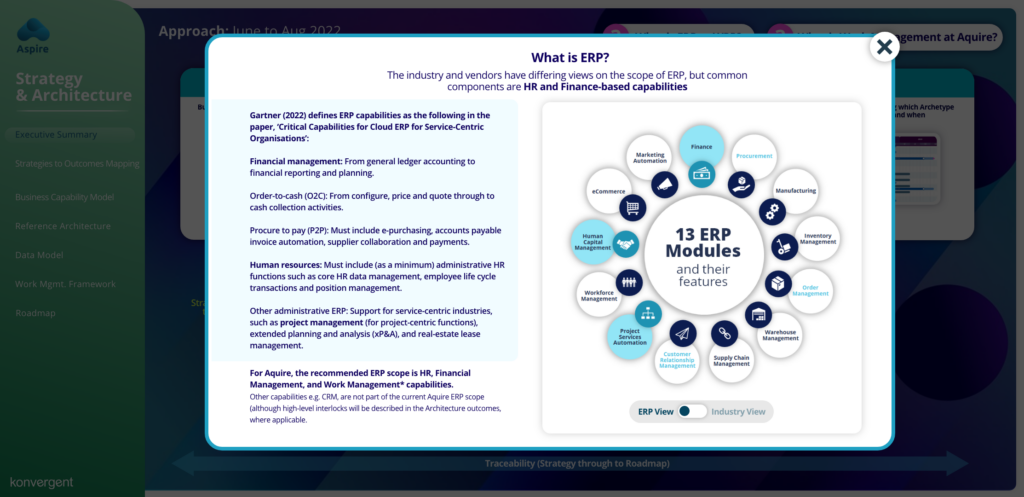A global media conglomerate with 10+ Operating Companies in over 50 markets is in the process of rolling out a global ERP Strategy spanning HR, Financial Management and Professional Services Automation.
The strategy must resolve significant complexity, costs and inconsistencies resulting from a highly fragmented legacy estate, with a multiplicity of different technologies & vendors and varying levels of bespoke functionality.
There are significant differences in the nature, scale and complexity of the various lines of business, a range of different regulatory and other local factors to consider, and resistance arising from an inconsistent understanding of the scope of the ERP strategy and the differences in functional coverage provided by the proposed strategic solutions.

To establish consensus and clarity in such a decentralised business with many different perspectives, we needed to definitively bust assumptions and misunderstandings around the ERP strategy’s purpose, scope and timeline. We needed to make information about the strategy easy to access, highly relevant & personalised, and easy to comprehend.
We started by breaking the problem down into three fundamental questions and addressed each in turn:
Our starting point was visualising the challenge using simple interactive diagrams reflecting specific information needs.
What is ERP? We broke this question down into three parts:


Who gets What, and Why? It was essential to set out the Business Motivation clearly and need for a strategic solution set, showing the connection from business drivers, to ERP solutions and through to the business outcomes they enable, along with the capability and functional fit for each market.

Who gets What, and When? The client needed a unified view of the global strategy and roadmap to align business leaders to a single, over-arching plan. By removing confusion around the Why and What and providing a clear understanding of what the ERP strategy would mean to each business area, we moved the conversation onto the art of the possible.


Konvergent used its architecture and visual communications capabilities to provide a ‘one-stop-shop’ for all things ERP strategy and roadmap, integrated into the client’s intranet. Through simple but high-quality visuals, using the language of Business Capabilities, and making the strategic context clear, over 12 weeks, Konvergent were able to help the client establish a broad understanding and consensus for a critical initiative that had been mired in complexity and misconception for over two years, and move forward with their global ERP program.
The portal has been maintained as a critical information resource for the wider business and is seen as a game-changer in such a complex organisation, enabling key stakeholders across the broader organisation to see their business area represented and understand the Why, What, How and When of the ERP strategy in the most precise and simplest terms.
Try the interactive portal for yourself, below:
In strategy and architecture, an often-neglected aspect is the Return on Investment (ROI). As financial professionals demand concrete figures when considering investments, more than a mere mention of process improvement or technology optimisation may be required. In their eyes, such endeavours represent costs, making it challenging to secure the necessary funding. Considering this, it is crucial to demonstrate ROI, regardless of how impressive a project’s visual outputs may be. How did Konvergent do this on this project?
“Value is a number, everything else is noise”
Consensus-building is a ubiquitous challenge for organisations and departments, with competing priorities often competing matters. Breaking the decision-making deadlock proved huge value to the client, but how do you calculate that? The answer is that is never an exact science but one based a series of deductions.
It was estimated that at least 50 people were involved in this project in some capacity, from key decision-makers at the CxO level to project support staff and dedicated programme resources. This does not include the cost of any external third parties outside of Konvergent.
At a conservative estimate, it was calculated that at least £2 million had been spent on salaries alone to achieve nothing other than deadlock. By getting everyone on the same page and getting the long-elusive consensus, Konvergent delivered an ROI of at LEAST 7x – 10x the original investment.






Konvergent,
The Hoxton, 70 Colombo St,
London,
SE1 8DP
T: +44 (0)20 3744 1256
E: info@konvergent.co.uk
| Cookie | Duration | Description |
|---|---|---|
| cookielawinfo-checkbox-analytics | 11 months | This cookie is set by GDPR Cookie Consent plugin. The cookie is used to store the user consent for the cookies in the category "Analytics". |
| cookielawinfo-checkbox-functional | 11 months | The cookie is set by GDPR cookie consent to record the user consent for the cookies in the category "Functional". |
| cookielawinfo-checkbox-necessary | 11 months | This cookie is set by GDPR Cookie Consent plugin. The cookies is used to store the user consent for the cookies in the category "Necessary". |
| cookielawinfo-checkbox-others | 11 months | This cookie is set by GDPR Cookie Consent plugin. The cookie is used to store the user consent for the cookies in the category "Other. |
| cookielawinfo-checkbox-performance | 11 months | This cookie is set by GDPR Cookie Consent plugin. The cookie is used to store the user consent for the cookies in the category "Performance". |
| viewed_cookie_policy | 11 months | The cookie is set by the GDPR Cookie Consent plugin and is used to store whether or not user has consented to the use of cookies. It does not store any personal data. |